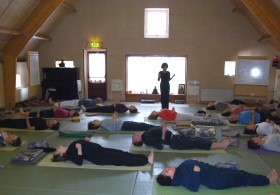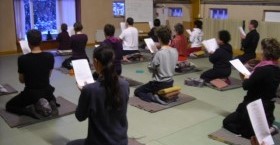

The teacher trainees and others who were interested in this theme gathered at an Okido Yoga residential seminar on the weekend of 22 - 24 February 2013, in Laren Dojo, Holland. After arrival, the Friday evening programme was divided into three groups: the teacher trainees presented their homework with Mizue, the Do-In group practiced with Anneke, and the footbath group warmed their feet; then the best preparation for the next day, a good night's sleep!
On Saturday morning, Saturday afternoon and Sunday morning, I gave a total of 10 hours intensive study on the theme: Conscious Action and Relaxation in Asana Practice.
This subject has gradually grown within me over many years since I started learning Okido Yoga in 1978. When I look back on how it came up, I can recall two aspects.
First: I have seen many people practice yoga exercises in painful ways, with short-lasting pushes and subsequent collapses or pains. Second: for a long time I have been holding a questioning thought on the expression ‘Do Consciously’, which has been so often used in Okido Yoga. Trying literally to follow these words, I experienced big swings in my mind between duty and self-judgement. I have also seen many people who seem to be in a similar struggle as mine.
This does not seem to concur with Oki sensei's motto in yoga practice: Force Not, Waste Not, but Continue. I had to continually think and try out in order to find out how to protect myself and be happy with my practice. ‘How can I reduce big swings between forcing and collapsing, duty and self-judgement, or over-excitement and exhaustion or possible accidents?’ ‘How can I make the most of asana practice in order to benefit both body and mind?’ My method has grown from this basis and is, of course, still developing.
On Saturday, I shared my experience with the participants, using stretching exercises, partner exercises and traditional yoga poses.
In whatever exercises you choose to do, set your position by taking care of the basic principles of posture regarding pelvis, pubic bones, collar bones, neck, big toes and little fingers. Then, take an action up to your maximum, notice the tension, withdraw a little from there, bring space to observe and be there for a while without changing pressure and with your awareness in natural breathing. Then, come back to the original base and restart the same process. You will notice you can go a little further on the second or third go.
When you get used to this basic pattern, you can build up without coming back to the original base. In this case, where you are 'being with your awareness in natural breathing’, becomes the second base. Thus the pressure level can climb higher, or stimulation can go deeper, little by little. It is important not to think that visibly doing more has greater value than less visible action. This is because such eagerness may push you against what your body prefers.

The idea and method were received very well. I explained: “We perhaps tend to be 'doing' too much in modern life, but this method values ‘doing’ and ‘being’ equally”. Then among some participants came up a phrase: do-be-do-be-do-, imitating an animated cartoon, Scooby-Doo.
However, it is not alternating physical gestures as ‘work, rest, work, rest, …’ In ‘do-be-do-be-do-’, the hyphens contain many activities of the conscious mind: Noticing your maximum tension, noticing that a little withdrawal alters sharp tension to a distribution of the stimulation, holding the same pressure in awareness, deciding your next move by consulting Lifeforce working inside you, reconfirming the basic principles of posture, etc. As a whole, this method makes each exercise work subtly with one’s inner feelings and produces a deeply-penetrating effect.
On Sunday, based on Saturday’s study, we practiced dynamic movements, using Okido Yoga Kyokaho exercises. These are also asanas in Okido Yoga. As soon as we get into movement, our attention tends to be largely taken up by 'doing'. But, in this seminar, I wanted the students to continue the way of ‘do-be-do-be-do-’, or maybe ‘doooo-be-doooo-be-doooo-’ for faster exercises. Can we insert moments of such ‘being’ awareness or reconfirmation of stability between repetitive dynamic movements? If we could be both ‘alert and in touch with our inner sense’ in these exercises, we would receive more benefits from them as avoiding problems that forced tension might create in the body. Also our mind would find an enjoyable rhythm in each event, which would result in more fun. My research is still developing. So, your feedback is welcome by e-mailing contact@okidoyoga.org.uk
Apart from my lessons, the morning chanting was led by Mizue, which included her guidance on basic posture and Okido philosophy. The whole seminar was supported by the dedicated staff: Anneke, Henriette, Saara and Valentina. Okido Yoga residential courses always include cleaning of the dojo as the last programme, which keeps alive the spirit of the old days in Mishima Dojo. The whole atmosphere was open, friendly, encouraging and inspiring.

The Okido Yoga Teacher Training run by Laren Dojo offers weekend seminars with specific themes taught by a number of different experienced teachers, as well as one-week dojo trainings and half-fasting trainings. If you are interested, please contact Mizue Tamaki ( okidoholland@hotmail.com, website: www.okidoyoga.nl ). For UK residents, please contact me because Okido Yoga UK runs a joint teacher-training with study in both Laren and the UK.
Please understand the full content through your experience before you use this method for other than your own practice. Attending my workshops is recommended.
© 2025 Okido Natural Health Education Trust CIO
Charity Registration No: 326669 (England & Wales)